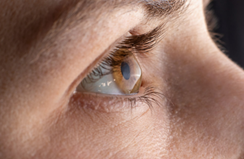
Sight is one of the five basic senses and keeping up with preventative eye care is just as important as scheduling an annual physical exam or dental cleaning. Often, when people think of health, they neglect to consider eye health, especially if they are not experiencing any vision issues. That’s why annual eye exams and vision checks play a fundamental role in maintaining eye health and detecting potential issues early.
It’s estimated that 4.2 million Americans over the age of 40 suffer from uncorrectable vision impairment. Yet, early detection and timely treatment of eye conditions can be efficacious and cost-effective. Keeping up with annual eye exams is extremely important, as you can detect serious conditions earlier and potentially avoid vision loss or other complications. Attending your annual checkups is a great way to monitor vision changes and catch potentially harmful eye diseases like keratoconus.
Keratoconus symptoms typically first appear in individuals who are in their early teens to twenties, but keratoconus has been reported in a broad range of patient ages.¹ The disease is progressive, so, early detection and treatment is critical, as your eyesight can worsen over time if left untreated. Proactively taking care of your eyes will ensure you stay current with your prescription and can help your doctor detect any progression.

This blog will share ways to take control of your eye health following a keratoconus diagnosis, including symptoms to watch for that may indicate the disease is progressing, understanding available treatment options, and ways to protect your eye health.
Experiencing Vision Changes? Be an Advocate for Yourself or a Loved One
Progressive keratoconus can result in long-term vision problems, as the disease can worsen over time and cause permanent vision loss. If you or a loved one think your keratoconus may be progressing, there are certain warning signs you should look out for!
Keratoconus can also be genetic, so it is essential to know if any family members have been diagnosed with the disease and to make them aware that they should be monitoring their eye health regularly. Informing a healthcare provider of family history is essential. This way, they can regularly check for keratoconus and make a diagnosis when warranted. You should also monitor your children for any signs that they may be struggling with their vision. It may even be worthwhile to speak with a teacher to make sure they don’t have any difficulty seeing the board, concentrating in class, or anything else that might indicate worsening vision.
Each eye may be affected differently, so here’s what to expect if you think your condition may be progressive or a loved one may have progressive keratoconus:
- Slight blurring of vision or distorted vision not fully correctable with glasses
- Increased sensitivity to light
- Eye redness or swelling
- Changes in the shape of the eye
- Frequent changes in eyeglass prescriptions
- Halos and ghosting
- Excessive eye rubbing
- Eye irritation
- Headaches
Understanding Keratoconus Treatment Options
We understand that learning you or a family member has progressive keratoconus may be overwhelming, but there are treatment options to help manage the condition. Depending on the severity of the disease, treatment options can range from glasses to corneal transplant surgery, or something in between.
Your doctor should take the time to talk through your different treatment options. Below are a few treatment options your doctor may suggest:
Intervention – To Halt or Slow Disease Progression
- iLink® FDA-Approved Cross-Linking Procedure: iLink® is the only cross-linking procedure that is FDA-approved. It is a minimally invasive outpatient procedure meant to slow or halt the progression of keratoconus to help preserve vision.
Vision Rehabilitation
- Eyeglasses or Soft Contacts: Some mild or early cases of keratoconus can be managed through traditional non-specialty eyeglasses or contact lenses.
- Rigid Gas Permeable Contact Lenses (RGPs): These lenses are made of durable plastic that can transmit oxygen. Scleral contact lenses are a specific type of gas permeable lenses that are larger in diameter and designed to cover the entire cornea plus a portion of the white of the eye.
- Intacs® (Corneal Implants): Thin plastic, semi-circular rings, which are surgically inserted under the surface of the cornea. When inserted, they flatten the cornea, changing its shape, and ultimately reducing corneal irregularities caused by keratoconus.
End-Stage Surgery
- Corneal Transplant Surgery: For the most severe cases of keratoconus, a corneal transplant may be the only treatment option available if sufficient vision can no longer be achieved by contact lenses.
Protecting Your Eyes
Taking the steps to protect your eyes is a must. There are many things you can do to protect your eyes, such as attending regular eye checkups! Staying on top of your eye health may seem tedious, but it is crucial for long-term health.
Here are some ways you can protect your eyes:
- Keep Up With Your Appointments: Don’t forget to schedule your annual eye exams! If you decide to be treated with iLink®, you may also be prescribed new lenses, such as scleral lenses. It is recommended to see your eye doctor regularly to ensure that your lenses fit correctly and that your prescription does not need to be adjusted. So, keep your regular eye appointments, no matter how busy you may be.
- Always Wear Sunglasses: In addition to the daily care of your lenses and protecting your eyes, you should also consider even more protection when it’s sunny out. Extra protection can be as simple as packing your sunglasses for a day at the beach.
- Monitor Screen Time: Be mindful of screen time, especially at night. Taking regular screen breaks can help reduce eye strain and protect your eyes.
Keep It Up!
Even after treating your progressive keratoconus, you should keep up with your eye health. Make sure you are diligently getting eye exams, avoiding the urge to rub your eyes, taking care of your lenses, and protecting your eyes. Preserving your vision is important, so prioritize scheduling regular eye appointments and checkups!
For more information on keratoconus and available treatment options, visit our website and follow Living with KC on Facebook, Twitter, and Instagram.
1. Valdez-Garcia JE, Sepúlveda R, Salazar-Martínez JJ, Lozano-Ramírez JF, Prevalence of keratoconus in an adolescent population. Rev Mex Oftalmol. 2014;88(3):95-98.

